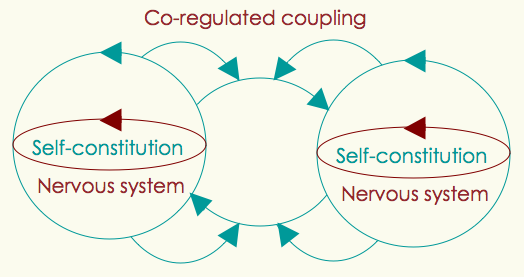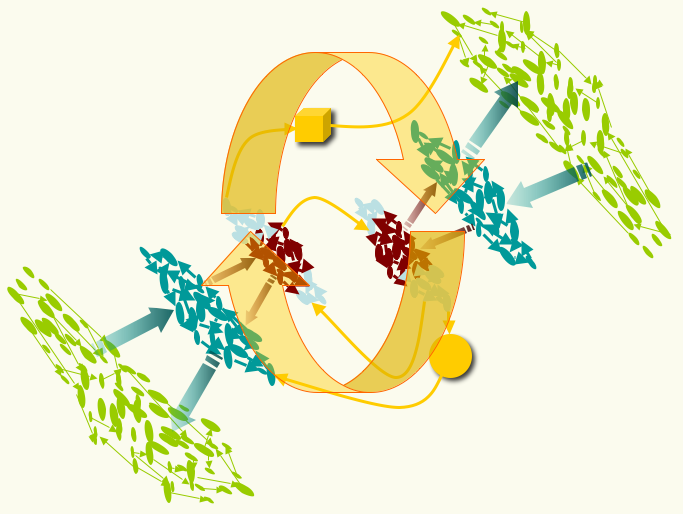Participatory sense-making
|
Research on social cognition needs to overcome a disciplinary
disintegration. On the one hand, in cognitive science and philosophy of mind -
even in recent embodied approaches - the explanatory weight is still overly on
individual capacities. In social science on the other hand, the investigation of the
interaction process and interactional behaviour is not often brought to bear on
individual aspects of social cognition. Not bringing these approaches together has
unfairly limited the range of possible explanations of social understanding to the
postulation of complex or mysterious internal mechanisms (e.g., contingency detection modules, mirror neurons).
|

|
|
We extend the enactive concept of sense-making into the social domain. It takes as its
departure point the process of interaction between individuals in a social encounter.
It is a well-established finding that individuals can and generally do coordinate their
movements and utterances in such situations. We argue that the interaction process itself
can take on a form of autonomy (operationally defined). This allows us to reframe the problem of social
cognition as that of how meaning is generated and transformed in the interplay
between the unfolding interaction process and the individuals engaged in it. The
notion of sense-making in this realm becomes participatory sense-making. This notion defines a spectrum of participation, from simpler cases of orientation of individual sense-making to joint sense-making (exemplified in acts that can only be completed socially, like the act of handing in an object). The onus
of social understanding thus moves away from strictly the individual only.
|
|
De Jaegher, H., and Di Paolo, E. A. (2007) Participatory sense-making: An enactive approach to social cognition. Phenomenology and the Cognitive Sciences, 6(4), 485 - 507.
De Jaegher, H. and Di Paolo, E. A. (2008) Making sense in participation: An enactive approach to social cognition. In F. Morganti, A. Carassa, and G. Riva (eds) Enacting Intersubjectivity: A cognitive and social perspective to the study of interactions, IOS Press: Amsterdam, forthcoming.
Di Paolo, E. A. (2008) A mind of many. Constructivist Foundations, 3(2): 89 - 91.
|
Social autonomy and organizational transitions

|
There are good reasons behind Francisco Varela's reticence to apply the idea of autopoiesis to anything other than proper living organisms. For all its potential to open up to organizational theory a vocabulary able to capture much of the autonomy and complexity of living systems, a direct or even a metaphorical application of autopoiesis also forces conceptual limitations that a) do not directly pertain to the phenomenology of social organizations and b) may lead to dangerous practices. It is therefore important to attempt disclose what aspects of autopoiesis may still apply to higher forms of organizations as well as what novel systemic properties pertain to them but not to autopoiesis.
|
|
An enactive approach may resolve the question of why the idea of autopoiesis is intuitively applicable to the case of some social organizations and yet it has failed to make a difference in practice. Indeed, the many transitions along the paths linking life, mind, society show signs both of conservation and overcoming of the properties that
precede them. It is therefore true that some aspects that make up autopoietic systems share properties with later modes of organization, both cognitive and social. But new modes introduce novelties that often re-define the game and even explicitly overcome aspects that were definitional of the preceding modes.
|
|
For social organizations, the enactive approach provides a much less restrictive systemic perspective than pure autopoiesis (much less focused on issues of boundaries, less likely to lead to alienating practices that negate the proper autonomy of individuals by assigning them a role of replaceable components, and less prone to generating conflicting relations between social system and milieu). In particular, this approach is better posed to describe and analyse tensions between different levels and the mechanisms through which individual, organizational, and larger contextual forms of autonomy interact forming networks of inner relations.
Some of these insights may be applied to the relatively novel phenomenon of self-managed businesses and factories in Argentina and other countries in Latin America as they provide the clearest examples of why a naked application of the idea of autopoiesis is inappropriate. In contrast, an informed enactive approach, based on autonomy and cognitive engagement, rescues several systemic notions pertaining to the concept of autopoiesis but avoids its limitations and allows a better understanding of these organizations.
|

|

|
|
Di Paolo, E. A. (forthcoming). Overcoming autopoiesis: an enactive detour on the way from life to society. In R. Magalhaes and R. Sanchez (eds), Autopoiesis in Organizations and Information Systems, Advanced Series in Management, Elsevier Science.
|
|